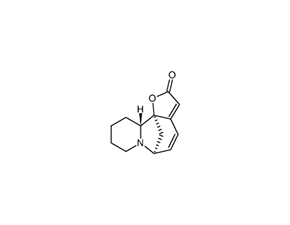
Securinine
CAS No. 5610-40-2
Securinine( (-)-Securinine )
Catalog No. M21463 CAS No. 5610-40-2
(-)-Securinine is plant-derived alkaloid and also a GABAA receptor antagonist.
(-)-Securinine is plant-derived alkaloid and also a GABAA receptor antagonist.
Purity : >98% (HPLC)
 COA
COA
 Datasheet
Datasheet
 HNMR
HNMR
 HPLC
HPLC
 MSDS
MSDS
 Handing Instructions
Handing Instructions
| Size | Price / USD | Stock | Quantity |
| 5MG | 45 | In Stock |


|
| 10MG | 75 | In Stock |


|
| 25MG | 156 | In Stock |


|
| 50MG | 229 | In Stock |


|
| 100MG | 343 | In Stock |


|
| 200MG | Get Quote | In Stock |


|
| 500MG | Get Quote | In Stock |


|
| 1G | Get Quote | In Stock |


|
Biological Information
-
Product NameSecurinine
-
NoteResearch use only, not for human use.
-
Brief Description(-)-Securinine is plant-derived alkaloid and also a GABAA receptor antagonist.
-
Description(-)-Securinine is plant-derived alkaloid and also a GABAA receptor antagonist.(In Vitro):(-)-Securinine is a major plant-derived alkaloid and also a GABAA receptor antagonist. (-)-Securinine is significantly potent on HeLa cells growth inhibition with IC50 values of 7.02±0.52 μg/mL (32.3 μM). (-)-Securinine induces apoptosis in a dose-dependent manner in the tested cells, increases the percentage of ROS positive cells and depolarized cells as well as stimulates the activity of ERK1/2, caspase-9 and -3/7. (-)-Securinine also induces cell cycle arrest in S phase. Real-time PCR analysis shows high expression of tumor necrosis factor receptor superfamily (TNFRSF) genes in the cells stimulated with (-)-Securinine.(In Vivo):In this tumor model, tumor growth is significantly impaired with (-)-Securinine treatment indicating that (-)-Securinine has potential as an Acute Myeloid Leukemia (AML) therapeutic. (-)-Securinine treated mice (n=5 mice, bilateral tumors), exhibit an average of more than 75% smaller tumors than vehicle treated mice at the end of the study period.
-
In Vitro(-)-Securinine is a major plant-derived alkaloid and also a GABAA receptor antagonist. (-)-Securinine is significantly potent on HeLa cells growth inhibition with IC50 values of 7.02±0.52 μg/mL (32.3 μM). (-)-Securinine induces apoptosis in a dose-dependent manner in the tested cells, increases the percentage of ROS positive cells and depolarized cells as well as stimulates the activity of ERK1/2, caspase-9 and -3/7. (-)-Securinine also induces cell cycle arrest in S phase. Real-time PCR analysis shows high expression of tumor necrosis factor receptor superfamily(TNFRSF) genes in the cells stimulated with (-)-Securinine.
-
In VivoIn this tumor model, tumor growth is significantly impaired with (-)-Securinine treatment indicating that (-)-Securinine has potential as an Acute Myeloid Leukemia (AML) therapeutic. (-)-Securinine treated mice (n=5 mice, bilateral tumors), exhibit an average of more than 75% smaller tumors than vehicle treated mice at the end of the study period.
-
Synonyms(-)-Securinine
-
PathwayOthers
-
TargetOther Targets
-
RecptorGABAA
-
Research Area——
-
Indication——
Chemical Information
-
CAS Number5610-40-2
-
Formula Weight217.26
-
Molecular FormulaC13H15NO2
-
Purity>98% (HPLC)
-
SolubilityDMSO:2 mg/mL (9.21 mM)
-
SMILESO=C1O[C@](C2)([C@@H](CCCC3)N3[C@@H]2C=C2)C2=C1
-
Chemical Name(6S11aR11bS)-9101111a-tetrahydro-8H-611b-methanofuro[23-c]pyrido[12-a]azepin-2(6H)-one
Shipping & Storage Information
-
Storage(-20℃)
-
ShippingWith Ice Pack
-
Stability≥ 2 years
Reference
1.Stefanowicz-Hajduk J et al. Securinine from Phyllanthus glaucus Induces Cell Cycle Arrest and Apoptosis in Human Cervical Cancer HeLa Cells. PLoS One. 2016 Oct 28;11(10):e0165372.
molnova catalog



related products
-
Ataquimas
Ataquimast inhibits IL-5 secretion along with that of TNF-a, IL-4 and GM-CSF from human cells.
-
Peonidin-3-O-glucosi...
Peonidin-3-O-glucoside chloride has antioxidant activity, is a radical scavenger.
-
Xenopsin 2TFA(51827-...
Xenopsin(2TFA) is a neurotensin-like octapeptide?previously isolated from amphibian skin.The octapeptide xenopsin, previously isolated from amphibian skin, stimulates exocrine pancreatic secretion of bicarbonate and protein in conscious dogs and increases the volume of secretion.



 Cart
Cart
 sales@molnova.com
sales@molnova.com


